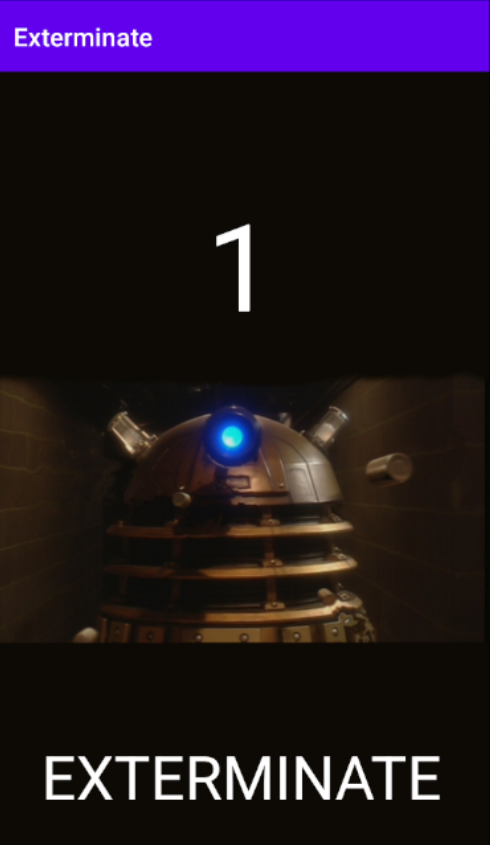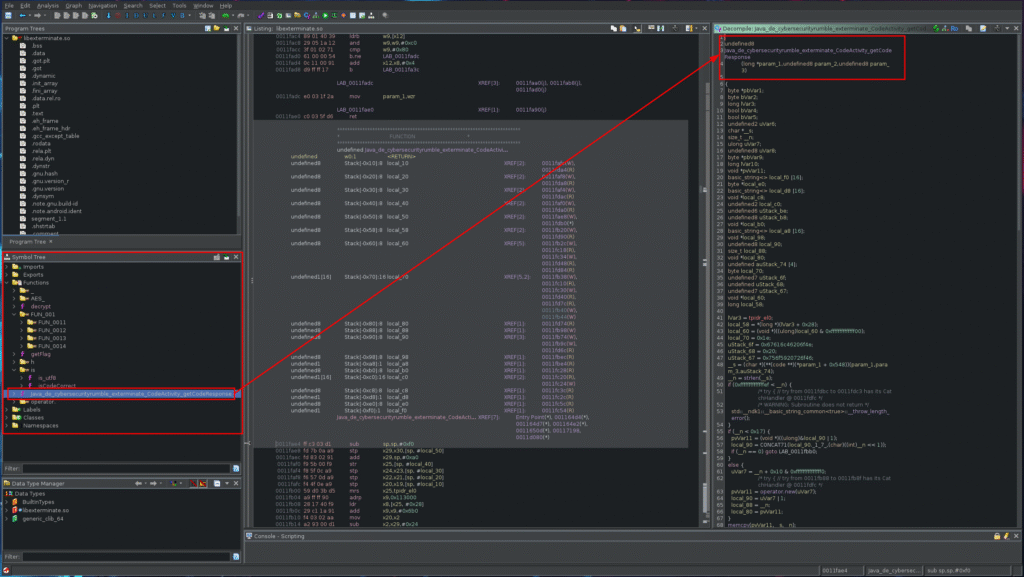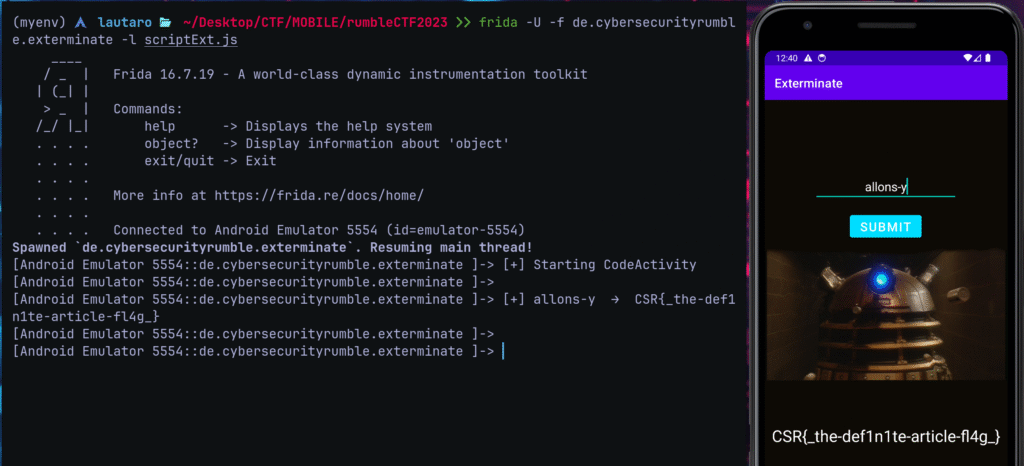Description: Daleks have invaded the earth and the Doctor is nowhere to be seen. Now it’s up to you to find out how they are built and which code can stop the extermination of all humankind.

Install the .apk file using ADB
adb install -r exterminate.apk
We can see that when the app is launched, there are a countdown of 3 seconds and then, EXTERMINATE text is printed on screen. Finally, the app is closed.
Let’s inspect the source code using JADX.
In the AndroidManifest.xml we found these activities:
<activity
android:name="de.cybersecurityrumble.exterminate.CodeActivity"
android:exported="false"/>
<activity
android:name="de.cybersecurityrumble.exterminate.CountdownActivity"
android:exported="true">
<intent-filter>
<action android:name="android.intent.action.MAIN"/>
<category android:name="android.intent.category.LAUNCHER"/>
</intent-filter>
</activity>
Where CountdownActivity is the main activity, and obviously is exported. And also, we can see the CodeActivity. Which isn’t exported.
Let’s see the CountdownActivity class, useful code:
new CountDownTimer() { // from class: de.cybersecurityrumble.exterminate.CountdownActivity$onCreate$timer$1
/* JADX WARN: 'super' call moved to the top of the method (can break code semantics) */
{
super(3000L, 1000L);
}
@Override // android.os.CountDownTimer
public void onTick(long millisUntilFinished) {
objectRef.element.setText(String.valueOf(intRef.element));
if (intRef.element == 1) {
objectRef2.element.setVisibility(0);
}
intRef.element--;
}
@Override // android.os.CountDownTimer
public void onFinish() {
System.exit(0);
throw new RuntimeException("System.exit returned normally, while it was supposed to halt JVM.");
}
}.start();
Here’s the function where countdown occurs.
Also:
public final void switchActivity() {
startActivity(new Intent(this, (Class<?>) CodeActivity.class));
}
The switchActivity(), that opens CodeActivity class.
In the CodeActivity we can see the following objects:
Intrinsics.checkNotNullExpressionValue(findViewById, "findViewById(R.id.input_code)");
Intrinsics.checkNotNullExpressionValue(findViewById2, "findViewById(R.id.button_submit)");
Intrinsics.checkNotNullExpressionValue(findViewById3, "findViewById(R.id.text_response)");
But the most important part is:
static {
System.loadLibrary("exterminate");
}
Where an native library is loaded.
Let’s use ghidra for binary analysis.
But first we need decompile the .apk using apktool
apktool d exterminate.apk
In exterminate/lib/arm64-v8a directory, we can see the libexterminate.so.
Import in ghidra and let’s see some useful functions.
Well, we can see a couple of functions in the library.
Java_de_cybersecurityrumble_exterminate_CodeActivity_getCodeResponseis_utf8isCodeCorrectgetFlagdecrypt
I will avoid placing the code for each function. However, you can find these functions in the Symbol Tree on the left.

Functions
getCodeResponse
This is a JNI that is “exposed” to the UI. I mean, when you insert a code in the CodeActivity (input), the getCodeResponse will be executed first.
The function flow is:
- Convert jstring ->
std::string. isCodeCorrect(s)-> bool.- If true ->
getFlag(s); otherwise load literal “No Flag For You”. - Return the result to Java.
is_utf8
UTF-8 sequence validator (while loop with masks 0xE0/0xF0/0xF8).
Reject any byte ≥ 0x80 that does not match UTF-8; if it fails, the app replaces it with “Wrong Code”.
isCodeCorrect
Contains a 8-byte filter:
• len == 8
• code[1] == code[2]
• Contains substring “on”
• code[6] == ‘–’
• All alphabetic (isalpha)
This can help us if we wanna bruteforce
getFlag
Copy code to stack, concatenate literal “geronimo” → AES-128 key. Call decrypt(ptrKey) to decrypt 32 hardcoded bytes and push the result to a std::string that returns to getCodeResponse.
decrypt
The two encrypted blocks:
C1 = c7e98af11a35c8a8...
C2 = d66d203aadabea4f...
They are decrypted with <code> + geronimo.
The chain of execution:
UI -> Java: onClick("<code>")Java -> JNI: getCodeResponse("<code>")JNI -> Native: isCodeCorrect()Native -> JNI: trueJNI -> Native: getFlag()Native -> Native: decript("<code>" + "geronimo")Native -> JNI: "CSR{...flag...}"JNI -> Java: jstring flagJava -> UI: show flag in text view
I want to divide in two parts this challenges.
The first part is stopping the countdown and call the CodeActivity so we can put the code.
For this, I develop a frida script that skip the System.Exit() function and start the activity CodeActivity:
Java.perform(() => {
// kill system exit
Java.use('java.lang.System').exit.implementation = () => {};
Java.use('de.cybersecurityrumble.exterminate.CountdownActivity$onCreate$timer$1')
.onFinish.implementation = () => {};
// log flag
const CA = Java.use('de.cybersecurityrumble.exterminate.CodeActivity');
CA.getCodeResponse.implementation = function (code) {
const res = this.getCodeResponse(code);
console.log(`[+] ${code} → ${res}`);
return res;
};
// launch code activity (and delay)
function launchWhenReady() {
const app = Java.use('android.app.ActivityThread').currentApplication();
if (app) {
setTimeout(() => {
const ctx = app.getApplicationContext();
const Intent = Java.use('android.content.Intent');
const CodeAct= Java.use('de.cybersecurityrumble.exterminate.CodeActivity');
const i = Intent.$new(ctx, CodeAct.class);
i.addFlags(0x10000000); // NEW_TASK
ctx.startActivity(i);
console.log('[+] Starting CodeActivity');
}, 5000);
} else {
setTimeout(launchWhenReady, 100);
}
}
launchWhenReady();
});
We can launch the app and run frida with this command:
frida -U -f de.cybersecurityrumble.exterminate -l scriptExt.js
This will launch the app and 5 seconds later, the CodeActivity will be shown.
Notice that now we can insert and submit a code.
After a little research and reading the challenge description (I don’t know anything related to Doctor Who). I found the following information from a Google search:
““Fantastic,” “Allons-y,” and “Geronimo” are popular phrases associated with the Ninth, Tenth, and Eleventh Doctors, respectively, in Doctor Who“
allons-y -> Is the <code>.
Because as we previously mentioned…
Contains a 8-byte filter:
• len == 8
• code[1] == code[2]
• Contains substring “on”
• code[6] == ‘–’
• All alphabetic (isalpha)
The numbers in [] are positions, think that starting from 0.
code[1]andcode[2]==l
So, the final key for AES decryption is allyons-ygeronimo.
But, we can just insert allons-y, then, the Java code sends to JNI and libraries put together the key for decrypt the flag.

Flag: CSR{_the-def1n1te-article-fl4g_}
I hope you found it useful (:
Leave a Reply